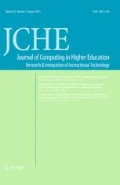Abstract
The paper proposes an interactive student response portfolio (ISREP) system with iBeacon and web-socket technology, which supports flipped-classroom learning activities in traditional classrooms. The design of the ISREP system aims at promote interactions in classroom learning (CL). It offers APPs and web-interface functions for students and teachers, respectively. Students’ APP can scan iBeacon devices in classrooms and then automatically upload their identification information to the cloud space. Consequently, students’ presence in classroom can be recorded automatically. Moreover, teachers employ another function the system provides to promote high interaction in classroom via displaying questions on the front screen in classroom. Meanwhile, it simultaneously pushes (multicasts) these questions to students’ smartphones via web-socket technology. Subsequently, students send their responses for questions to the cloud space by the APP. During answering questions, the system presents temporary histograms of students’ responses and counting-down statuses of a timer on the screen in classroom. A timer can be synchronized with students’ APP by the web-socket technology. This way can promote students’ interaction and interest and then students enjoy in quiz-like activities. Teachers can quickly get results of students’ responses. A quasi-experiment was conducted in flipped-CL activities of a university class utilizing the system. Observing experimental results, it was found that students, who receive the instruction with the system, improved their interaction, learning interest, learning attitude, and learning satisfaction. Moreover, the proposed system helps teachers quickly obtain students’ learning situation in classroom and then may adjust their instructional approaches or contents.









Similar content being viewed by others
References
Aktekin, N. C., Çelebi, H., & Aktekin, M. (2018). Let’s Kahoot! Anatomy. International Journal of Morphology, 36(2), 716–721.
Chen, D.-J., Lai, A.-F., & Liu, I.-C. (2005). The design and implementation of a diagnostic test system based on the enhanced S-P model. Journal of Information Science and Engineering, 21, 1007–1030.
Chiu, P. S., Chen, H. C., Huang, Y. M., Liu, C. J., Liu, M. C., & Shen, M. H. (2018). A video annotation learning approach to improve the effects of video learning. Innovations in Education and Teaching International, 55(4), 1–11.
Fette, I., & Melnikov, A. (2011, December). The WebSocket protocol. Internet engineering task force. Retrieved from https://tools.ietf.org/html/rfc6455.
Fuller, J. S., & Dawson, K. M. (2017). Student response systems for formative assessment: Literature based strategies and findings from a middle school implementation. Contemporary Educational Technology, 8(4), 370–389.
Gould, S. M. (2016). Potential use of classroom response systems (CRS, Clickers) in foods, nutrition, and dietetics higher education. Journal of Nutrition Education and Behavior, 48(9), 669–674.
Hwang, G. J., & Chang, H. F. (2011). A formative assessment-based mobile learning approach to improving the learning attitudes and achievements of students. Computers & Education, 56(4), 1023–1031.
Lewis, C. E., Chen, D. C., & Relan, A. (2017). Implementation of a flipped classroom approach to promote active learning in the third-year surgery clerkship. The American Journal of Surgery, 215(2), 298–303.
Lo, G., Lin, D., & Tang, W. H. (2015, April). Zuvio. Retrieved from http://aca.tmu.edu.tw/files/achive/1413_458220f3.pdf.
Malone, T. W. (1980). What makes things fun to learn? Heuristics for designing instructional computer games. In The 3rd ACM SIGSMALL symposium and the first SIGPC symposium on small systems (pp. 162–169).
Merchant, Z., Goetz, E. T., Keeney-Kennicutt, W., Kwok, O.-M., Cifuentes, L., & Davis, T. J. (2012). The learner characteristics, features of desktop 3D virtual reality environments; College chemistry instruction: A structural equation modeling analysis. Computers & Education, 59(2), 551–568.
Mishra, S. (2018, December). Introduction to WebSockets. Retrieved from https://linode.com/docs/development/introduction-to-websockets/.
Moore, M. G. (1989). Three types of interaction. The American Journal of Distance Education, 3(2), 1–6.
Plump, C. M., & LaRosa, J. (2017). Using Kahoot! in the classroom to create engagement and active learning: A game-based technology solution for eLearning novices. Management Teaching Review, 2(2), 151–158.
Siau, K., Sheng, H., & Nah, F. F.-H. (2006). Use of a classroom response system to enhance classroom interactivity. IEEE Transactions on Education, 49(3), 398–403.
Spachos, P. (2017, December). Computer communications. Retrieved from https://doi.org/10.1016/j.comcom.2017.12.007.
Townsend, K. (2018, March). Introduction to Bluetooth low energy. Retrieved from https://cdn-learn.adafruit.com/downloads/pdf/introduction-to-bluetooth-low-energy.pdf.
Wang, A. I. (2015). The wear out effect of a game-based student response system. Computers & Education, 82, 217–227.
Wang, B. T. (2016). Applying PBL and ZUVIO to enhance English learning motivation. International Journal of Cyber Society and Education, 9(1), 1–16.
Wu, Y.-C., Wu, J. T., & Li, Y. (2017, August). Impact of using classroom response systems on students’ entrepreneurship learning experience. Computers in Human Behavior. https://doi.org/10.1016/j.chb.2017.08.013.
Wu, Q. W., Wu, M. C., Liang, R. K., & Wang, X. Y. (1999). Team model smarter classroom. Retrieved from http://www.habook.com.tw/english/download/TEAM_Model/TEAM_Model_Smarter_Classroom.pdf.
Yilmaz, R. (2017). Exploring the role of e-learning readiness on student satisfaction and motivation in flipped classroom. Computers in Human Behavior, 70, 251–260.
Acknowledgements
The authors would like to acknowledge the Ministry of Science and Technology of Taiwan for supporting this research under Contract Numbers MOST 105-2511-S-150-003 and MOST 107-2511-H-150-001. The findings and recommendations contained in this article of those of the authors and do not necessarily reflect those of the Ministry of Science and Technology.
Author information
Authors and Affiliations
Corresponding author
Ethics declarations
Conflict of interest
No potential conflict of interest was reported by the authors.
Additional information
Publisher's Note
Springer Nature remains neutral with regard to jurisdictional claims in published maps and institutional affiliations.
Rights and permissions
About this article
Cite this article
Tsai, HH., Chang, CT., Hou, XY. et al. Interactive student response system with iBeacon and web-socket for flipped classroom learning. J Comput High Educ 31, 340–361 (2019). https://doi.org/10.1007/s12528-019-09226-x
Published:
Issue Date:
DOI: https://doi.org/10.1007/s12528-019-09226-x




